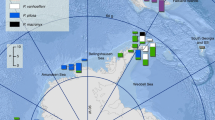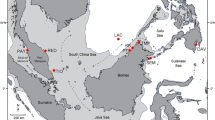Abstract
Individuals of two species in the reef goby genus Gnatholepis ( G. anjerensis and G. scapulostigma) were sampled from across the South Pacific, including the Society Islands, the Tuamotu Archipelago, the Cook Islands, and Fiji. The two species examined differ in habitat preference, with one (G. anjerensis) preferring shallow, lagoon habitats, and the other (G. scapulostigma) usually occupying habitats outside the lagoons. Partial sequence of the mitochondrial ND2 gene (451–483 base pairs) was determined for 267 individuals and analyzed for demographic structure, population structuring, and correlation of population structure with geographic distance between populations. Both species exhibit demography characteristic of population expansion in the Pleistocene, approximately 88,000 years ago for G. anjerensis and 237,000 years ago for G. scapulostigma. Comparisons of Φ st indicate more structuring among populations of G. anjerensis than G. scapulostigma, although only G. scapulostigma shows a significant correlation between geographic distance and population divergence. It is postulated that the population expansions in Gnatholepis species are related to Pleistocene fluctuations in sea level, and that the ecology of G. anjerensis populations may contribute to their greater population structuring.



Similar content being viewed by others
References
Ashton KG, deQueiroz A (2001) Molecular systematics of the western rattlesnake, Crotalus viridis (Viperidae), with comments on the utility of the D-loop in phylogenetic studies of snakes. Mol Phylogenetics Evol 21(2):176–189
Benzie JA (1999) Genetic structure of coral reef organisms: ghosts of dispersal past. Am Zool 39:131–145
Benzie JA, Williams ST (1997) Genetic structure of giant clam ( Tridacna maxima) populations in the west Pacific is not consistent with dispersal by present-day ocean currents. Evolution 51(3):768–783
Bermingham E, McCafferty SS, Martin AP (1997) Fish biogeography and molecular clocks: perspectives from the Panamanian isthmus. In: Kocher TD, Stepien CA (eds) Molecular systematics of fishes. Academic Press, San Francisco, pp 113–128
Chenoweth SF, Hughes JM, Connolly RC (2002) Phylogeography of the pipefish, Urocampus carinirostris , suggests secondary intergradation of ancient lineages. Mar Biol 141:541–547
Dawson MN, Louie KD, Barlow M, Jacobs DK, Swift CC (2002) Comparative phylogeography of sympatric sister species, Clevelandia ios and Eucyclogobius newberryi (Teleostei, Gobiidae), across the California Transition Zone. Mol Ecol 11:1065–1075
Dawson MN, Staton J, Jacobs DK (2001) Phylogeography of the tidewater goby, Eucyclogobius newberryi (Teleostei: Gobiidae), in coastal California. Evolution 55(6):1167–1179
Doherty PJ, Planes S, Mather P (1995) Gene flow and larval duration in seven species of fish from the Great Barrier Reef. Ecology 76(8):2373–2391
Dudgeon CL, Gust N, Blair D (2000) No apparent genetic basis to demographic differences in scarid fishes across continental shelf of the Great Barrier Reef. Mar Biol 137:1059–1066
Fairbanks RG (1989) A 17,000-year glacio-eustatic sea level record: influence of glacial melting rates on the Younger Dryas event and deep-ocean circulation. Nature 342:637–642
Grant WS, Bowen BW (1998) Shallow population histories in deep evolutionary lineages in marine fishes: insights from sardines and anchovies and lessons for conservation. J Heredity 89(5):415–426
Grant WS, Clark AM, Bowen BW (1998) Why restriction fragment length polymorphism analysis of mitochondrial DNA failed to resolve sardine ( Sardinops) biogeography: insights from mitochondrial DNA cytochrome b sequences. Can J Fish Aquat Sci 55:2539–2547
Graves JE (1998) Molecular insights into the population structures of cosmopolitan marine fishes. J Heredity 89(5):427–437
Harpending HC, Batzer MA, Gurven M, Jorde LB, Rogers AR, Sherry ST (1998) Genetic traces of ancient demography. Proceedings of the National Academy of Sciences USA 95, pp 1961–1967
Jones GP, Milicich MJ, Emslie MJ, Lunow C (1999) Self-recruitment in a coral reef fish population. Nature 402:802–804
Leis JM, Sweatman HPA, Reader SE (1996) What the pelagic stages of coral reef fishes are doing out in blue water: daytime field observations of larval swimming abilities. Mar Freshwater Res 47:401–411
Macey JR, Schulte JAII, Ananjeva NB, Larson A, Rastegar-Pouyani N, Shammakov SM, Papenfuss TJ (1998a) Phylogenetic relationships among agamid lizards of the Laudakia caucasia species group: Testing hypotheses of biogeographic fragmentation and an area cladogram for the Iranian Plateau. Mol Phylogenetics Evol 10:118–131
Macey JR, Schulte JAII, Larson A, Fang Z, Wang Y, Tuniyev BS, Papenfuss TJ (1998b) Phylogenetic relationships of toads in the Bufo bufo species group from the eastern escarpment of the Tibetan Plateau: A case of vicariance and dispersal. Mol Phylogenetics Evol 9:80–87
Macey JR, Wang Y, Ananjeva NB, Larson A, Papenfuss TJ (1999) Vicariant patterns of fragmentation among gekkonid lizards of the genus Teratoscinctus produced by the Indian collision: a molecular phylogenetic perspective and an area cladogram for central Asia. Mol Phylogenetics Evol 12:320–332
McMillan WO, Palumbi SR (1995) Concordant evolutionary patterns among Indo-West Pacific butterflyfishes. Proceedings R Soc Lond, Series B 260, 229–236
Nunn PD (1994) Oceanic islands. Blackwell, Oxford
Palumbi SR, Warner RR (2003) Why gobies are like hobbits. Science 299:51–52
Paulay G (1990) Effects of late Cenozoic sea-level fluctuations on the bivalve faunas of tropical oceanic islands. Paleobiology 16(4):415–434
Pezold FL (1993) Evidence for a monophyletic Gobiinae. Copeia 1993:634–643
Planes S (1993) Genetic differentiation in relation to restricted larval dispersal of the convict surgeonfish Acanthurus triostegus in French Polynesia. Mar Ecol Prog Ser 98:237–246
Planes S, Bonhomme F, Galzin R (1993) Genetic structure of Dascyllus aruanus populations in French Polynesia. Mar Biol 117:665–674
Planes S, Doherty PJ, Bernardi G (2001) Strong genetic divergence among populations of a marine fish with limited dispersal, Acanthochromis polyacanthus , within the Great Barrier Reef and Coral Sea. Evolution 55(11):2263–2273
Planes SR, Galzin R, Bonhomme F (1996) A genetic metapopulation model for reef fishes in oceanic islands: the case of the surgeonfish, Acanthurus triostegus. J Evol Biol 9:103–117
Porter SC (1989) Some geological implications of average Quaternary glacial conditions. Quat Res 32:245–261
Rice WR (1989) Analyzing tables of statistical tests. Evolution 43(1):223–225
Rogers AR, Harpending H (1992) Population growth makes waves in the distribution of pairwise genetic distances. Mol Biol Evol 9(3):552–569
Schneider S, Roessli D, Excoffier L (2000) Arlequin version 2.000: software for population genetics data analysis. Genetics and Biometry Laboratory, University of Geneva, Switzerland
Shackleton NJ (1987) Oxygen isotopes, ice volume and sea level. Quat Sci Rev 6:183–190
Shulman MJ (1998) What can population genetics tell us about dispersal and biogeographic history of coral-reef fishes? Aust J Ecol 23:216–225
Shulman MJ, Bermingham E (1995) Early life histories, ocean currents, and the population genetics of Caribbean reef fishes. Evolution 49(5):897–910
Swearer SE, Caselle JE, Lea DW, Warner RR (1999) Larval retention and recruitment in an island population of a coral reef fish. Nature 402:799–802
Swofford DL (2001) PAUP*: Phylogenetic Analysis Using Parsimony *and other Methods. Version 4.08b, Sinauer Associates, Sunderland, Massachusetts
Taylor MS, Hellberg ME (2003) Genetic evidence for local retention of pelagic larvae in a Caribbean reef fish. Science 299:107–109
Victor BC, Wellington GM (2000) Endemism and the pelagic larval duration of reef fishes in the eastern Pacific Ocean. Mar Ecol Prog Ser 205:241–248
Weisrock DW, Macey JR, Ugurtas IH, Larson A, Papenfuss TJ (2001) Molecular phylogenetics and historical biogeography among salamandrids of the “true” salamander clade: rapid branching of numerous highly divergent lineages with the rise of Anatolia in Mertensiella luschani. Mol Phylogenetics Evol 18:450–464
Whittaker RJ (1998) Island biogeography: ecology, evolution and conservation. Oxford University Press, Inc., New York
Acknowledgements
A. Thompson, J. White, B. Wolcott, J. Blythe, and D. Geiger provided expert field assistance during collection trips throughout the South Pacific. Specimens were collected under scientific research permit no. 357 from the Haut-Commissariat de la Republique en Polynesie Francaise and under permit no. 12/01 from the government of the Cook Islands. K. Johnson provided information about patterns of sea level change associated with Pleistocene glaciation, C. Reeb provided valuable advice on methods and analyses, and D. Geiger assisted with statistical tests. This is contribution number 7 of the W. M. Keck Foundation Program in Molecular Systematics and Evolution at the Natural History Museum of Los Angeles County.
Author information
Authors and Affiliations
Corresponding author
Additional information
Communicated by P.F. Sale
Rights and permissions
About this article
Cite this article
Thacker, C.E. Population structure in two species of the reef goby Gnatholepis (Teleostei: Perciformes) among four South Pacific island groups. Coral Reefs 23, 357–366 (2004). https://doi.org/10.1007/s00338-004-0391-0
Received:
Accepted:
Published:
Issue Date:
DOI: https://doi.org/10.1007/s00338-004-0391-0




